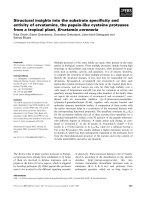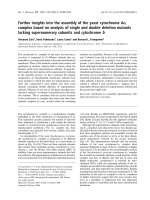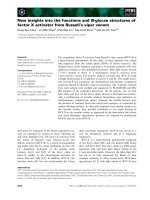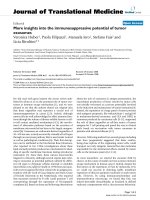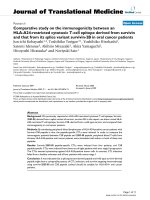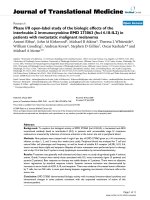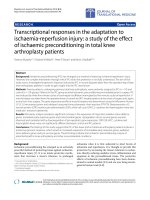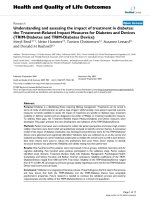báo cáo hóa học:" More insights into the immunosuppressive potential of tumor exosomes" pptx
Bạn đang xem bản rút gọn của tài liệu. Xem và tải ngay bản đầy đủ của tài liệu tại đây (224.53 KB, 4 trang )
BioMed Central
Page 1 of 4
(page number not for citation purposes)
Journal of Translational Medicine
Open Access
Editorial
More insights into the immunosuppressive potential of tumor
exosomes
Veronica Huber
1
, Paola Filipazzi
1
, Manuela Iero
1
, Stefano Fais
2
and
Licia Rivoltini*
1
Address:
1
Unit of Immunotherapy of Human Tumors, Fondazione IRCCS Istituto Nazionale Tumori, Milan, Italy and
2
Department of Drug
Research and Evaluation, Anti-Tumor Drugs Section, Istituto Superiore di Sanità, Rome, Italy
Email: Veronica Huber - ; Paola Filipazzi - ;
Manuela Iero - ; Stefano Fais - ; Licia Rivoltini* -
* Corresponding author
We did read with great interest the recent review pub-
lished by Ichim et al on the potential role of tumor exo-
somes as immune escape mechanism [1], and we were
pleased to see that the authors shared our original idea
that these organelles may represent a crucial tool of
immunosuppression in cancer [2,3]. Indeed, although
tumor cells are well acknowledged to affect immune func-
tions through the release of diverse soluble factors or cell-
to-cell contact mediated mechanisms [4,5], the involve-
ment of alternative pathways based on the secretion of
membrane microvesicles has been so far largely unappre-
ciated [6]. Exosomes are endosome-derived organelles of
50–100 nm size, actively secreted by virtually all cell types
through an exocytosis pathway that is used under normal
as well as pathological conditions [6]. Their first descrip-
tion can be attributed to the biochemist Rose Johnstone,
who reported in her 1980s investigations about these
lipid-encased particles produced as a mechanism for shed-
ding of specific membrane functions during reticulocyte
maturation [7]. Since then, these curious microvesicles
lingered in obscurity, although several reports kept refer-
ring to exosomes as potential pathway utilized by differ-
ent cell types to eliminate cellular material or establish
intercellular cross-talk [8]. Finally in 1996 these micropar-
ticles were recognized for their central role in antigen pres-
entation with the work of Graça Raposo and Hans Geuze
of Utrecht University in the Netherlands, who reported
that exosomes secreted by B cells could promote T cell
cross-priming through the expression of HLA/peptide
complexes [6]. Based on these and following observations
about the role of exosomes in antigen presentation, the
exacerbated production of these vesicles by tumor cells
was initially welcomed as a process potentially involved
in the induction and maintenance of tumor immunity [9].
Indeed, the expression of a large panel of tumor proteins
with antigenic properties, like MelanA/Mart-1 and gp100
in melanoma-derived exosomes, and CEA and HER2 in
exosomes produced by carcinoma cells [9-11], supported
the role of these organelles as cell-free source of tumor
antigens for T cell priming and paved the way to clinical
trials based on vaccination with tumor exosomes in
patients with advanced disease [12].
However, following studies from several groups including
ours have progressively suggested that these vesicles,
being close replicas of the originating cancer cells, could
transport not only antigenic material but also molecules
responsible for the detrimental effects exerted by tumor
cells on the immune system [6,13,14].
As most researchers, we entered the exosome field by
chance, in the course of studies on FasL as tumor immune
escape mechanism in human cancer. Indeed, despite the
first report on the expression of FasL by melanoma [15],
we could not succeed in detecting stable membrane
expression of this pro-apoptotic molecule on such tumor
cells. However, by using immunocytochemistry and
immunoelectron microscopy, we found that FasL was
indeed detectable intracellularly, as localized in defined
endocytic compartments with a clear secretory behaviour.
Published: 30 October 2008
Journal of Translational Medicine 2008, 6:63 doi:10.1186/1479-5876-6-63
Received: 24 October 2008
Accepted: 30 October 2008
This article is available from: />© 2008 Huber et al; licensee BioMed Central Ltd.
This is an Open Access article distributed under the terms of the Creative Commons Attribution License ( />),
which permits unrestricted use, distribution, and reproduction in any medium, provided the original work is properly cited.
Journal of Translational Medicine 2008, 6:63 />Page 2 of 4
(page number not for citation purposes)
Thanks to this initial observation, we discovered that
human melanoma as well as colon carcinoma cells consti-
tutively release FasL and TRAIL-expressing exosomes,
which induce death by apoptosis in activated T cells
[10,11]. This evidence, confirmed also by Whiteside and
coworkers in head and neck cancer [16], highlights a ger-
mane role of microvesicular structures in counteracting
tumor immunity by simply eliminating activated T cells
bearing tumor-reactive TCR. This might occur even at dis-
tance (in peripheral lymphoid organs, bone marrow,
peripheral blood, and biological fluids) without the need
for a direct cell-to-cell contact. And given the evidence that
exosome of probable tumor origin are abundantly found
in plasma or pathological effusions of cancer patients
[9,11], it can be easily hypothesized that this pathway
may contribute to the in vivo moulding of immune as
well as other cancer-related host responses. More recent
studies have then reported that the detrimental effect of
tumor exosome on immune effector functions is not
restricted to T cells but can target NK cells as well, through
the skewing of IL-2 responsiveness in favour of regulatory
T cells [17] or down-modulation of NKG2D expression
[18]. Moreover, the negative influence of tumor exosomes
on specific immunity goes beyond T and NK cells and
may also target crucial up-stream steps for T cell cross-
priming, namely dendritic cell (DC) differentiation. In
fact, we have more recently observed that the presence of
tumor exosomes during monocyte differentiation into DC
skews the whole process toward the generation of aber-
rant cells expressing myeloid markers (such as CD14 and
CD11b), lacking or bearing low levels of co-stimulatory
molecules (like HLA-DR, CD80 and CD86) and sponta-
neously secreting TGF-beta [19,20]. These cells, which
exert a strong immunosuppressive activity on T cell prolif-
eration and function, highly resemble the "myeloid-
derived suppressor cell" subset described to accumulate
with tumor progression in different murine models [21].
Interestingly enough, melanoma patients with advanced
disease have high levels of these CD14+ HLA-DR neg/low
TGF beta-secreting cells in their peripheral blood, and this
frequency appears to be a disadvantageous factor for the
development of immune responses to tumor vaccines
[20]. These findings, which again were confirmed in other
experimental settings [22], define a very sharp profile of
tumor exosomes as efficient delivery system of immuno-
suppression, contributing to the maintenance of an
immune tolerance state in cancer bearing hosts.
The interest on exosomes has recently spread out as these
vesicles are being found involved in a wide spectrum of
physiological and pathological cellular events, as alterna-
tive tools of intercellular communication and paracrine
functions [23], or as pathogenic pathways in viral [24]
and prion-related diseases [25]. Thanks to their peculiar
lipid composition, highly enriched in ceramide [26],
sphingomyelin, cholesterol and GM3 glycolipid [27], exo-
somes may serve as a more advantageous carrier of signal
delivery favouring stable conformational conditions,
increased bioactivity, improved bio-distribution and
amplified target interaction of their protein content with
respect to soluble molecules. In the last years, literature is
indeed flourishing with examples proving the role of
tumor exosomes in the transfer of growth factors and cog-
nate receptors to homologous or heterologous target cells.
For instance glioma cells can share EGFR by intercellular
transfer of membrane-derived microvesicles ('onco-
somes') [28], or pancreatic carcinoma can deliver exo-
somes overexpressing tetraspanin family members and
promoting autocrine secretion of MMP and VEGF [29].
The evidence that these organelles can also shape protein
synthesis through the transfer of functional mRNAs and
microRNAs, as recently reported in transformed masto-
cytes [30], adds then a further pathway to the potential
modulating properties of these peculiar organelles.
If tumor exosomes are such a powerful instrument of
environmental shaping, then getting rid of them should
significantly affect cancer cell ability to survive and
expand in vivo. In their review, Ichim et al propose a phys-
ical approach based on the extracorporeal removal of exo-
somes from plasma of cancer patients, through a novel
hollow-fiber cartridge (Hemopurifier™) designed to elim-
inate particles expressing heavily glycosylated surface pro-
teins, like in case of viruses and cancer microvesicles [1].
The approach could be further implemented by the
attachment of clinical grade molecules and antibodies to
the cartridge resin, to allow microvesicle depletion on the
basis of selected marker expression. Although interesting,
feasible and potentially effective in the short-term, this
strategy could only have an impact on circulating exo-
somes, leaving vesicles accumulating at tumor tissue level,
in draining lymph nodes or in other relevant lymphoid
compartments, still available for immunosuppressive
functions. Obviously, physical removal would not inter-
fere with the process of exosome secretion, and would
indiscriminately eliminate vesicles from both pathologi-
cal and normal cells. In alternative, we are considering to
intervene on tumor exosome secretion by inhibiting up-
stream crucial pathways involved in the process. Although
definitive information on the mechanisms regulating
microvesicle release by cancer cells are presently scantly,
preliminary data suggest that particular molecules, such as
drugs interfering with microtubule stability (taxanes and
vinca alkaloids) [M. Iero, unpublished observations] or
additional microtubule-disturbing molecules like vincris-
tine [31], can affect endosomal stability and reduce micro-
vesicle release. Similarly, drugs targeting the activity of
enzymatic efflux pumps expressed on acidic vacuoles,
such as vacuolar-ATPases inhibitors, could selectively alter
exosome trafficking and release in tumor cells [Iero et al.,
Journal of Translational Medicine 2008, 6:63 />Page 3 of 4
(page number not for citation purposes)
unpublished, [32]]. Benefits from modulation of exo-
some secretion could also come from qualitatively shap-
ing protein composition of secreted microvesicles with
drugs altering biological features of tumor vesicles, such
in the case of curcumin, a natural polyphenol which has
been shown to reduce immunosuppressive functions of
breast carcinoma-secreted exosomes [33].
A more specific approach would be instead to identify the
molecular mechanisms responsible for the immunosup-
pressive activity and the microenvironment remodelling
effects of tumor exosomes [34], to selectively interfere
with these pathways through specific antibodies, anti-
sense oligonucleotides or signalling inhibitors.
Independently from the tool utilized for diminishing exo-
some release by tumor cells, the most challenging task of
the near future is to prove that interfering with microvesi-
cle secretion in vivo may indeed result in tumor growth
arrest or slow-down thanks to the recovery of specific
immunity and the interruption of paracrine/autocrine
loops in tumor microenvironment. Prior to any clinical
intervention, experimental studies in animal models
should thus be performed to assess what is the real impact
that these vesicles play in cancer progression and what is
the expected benefit of shutting off their production at
tumor site.
Authors contributions
VH was responsible for editorial writing, senior scientist
responsible for the studies on the immunosuppressive
functions of tumor exosomes. PF was responsible for
editorial reviewing, scientist responsible for the studies on
the induction of myeloid-derived suppressor cells by
tumor exosomes. MI was responsible for editorial
reviewing, scientist responsible for the studies on the
modulation of exosome release by tumor cells. SF was
responsible for editorial reviewing, external collaborator
in the studies on the involvement of proton-pump inhib-
itors on exosome release. LR was responsible for edito-
rial writing and reviewing, supervisor of the studies on
tumor exosomes
References
1. Ichim TE, Zhong Z, Kaushal S, Zheng X, Ren X, Hao X, Joyce JA,
Hanley HH, Riordan NH, Koropatnick J, Bogin V, Minev BR, Min WP,
Tullis RH: Exosomes as a tumor immune escape mechanism:
possible therapeutic implications. J Transl Med 2008, 6:37.
2. Valenti R, Huber V, Iero M, Filipazzi P, Parmiani G, Rivoltini L:
Tumor-released microvesicles as vehicles of immunosup-
pression. Cancer Res 2007, 67:2912-2915.
3. Iero M, Valenti R, Huber V, Filipazzi P, Parmiani G, Fais S, Rivoltini L:
Tumour-released exosomes and their implications in cancer
immunity. Cell Death Differ 2008, 15:80-88.
4. Marincola FM, Jaffee EM, Hicklin DJ, Ferrone S: Escape of human
solid tumors from T-cell recognition: molecular mechanisms
and functional significance. Adv Immunol 2000, 74:181-273.
5. Rivoltini L, Canese P, Huber V, Iero M, Pilla L, Valenti R, Fais S, Loz-
upone F, Casati C, Castelli C, Parmiani G: Escape strategies and
reasons for failure in the interaction between tumour cells
and the immune system: how can we tilt the balance
towards immune-mediated cancer control? Expert Opin Biol
Ther 2005, 5:463-476.
6. van Niel G, Porto-Carreiro I, Simoes S, Raposo G: Exosomes: a
common pathway for a specialized function. J Biochem 2006,
140:13-21.
7. Johnstone RM: The Jeanne Manery-Fisher Memorial Lecture
1991. Maturation of reticulocytes: formation of exosomes as
a mechanism for shedding membrane proteins. Biochem Cell
Biol 1992, 70:179-190.
8. Johnstone RM: Exosomes biological significance: A concise
review. Blood Cells Mol Dis 2006, 36:315-321.
9. Andre F, Schartz NE, Movassagh M, Flament C, Pautier P, Morice P,
Pomel C, Lhomme C, Escudier B, Le Chevalier T, Tursz T, Amigorena
S, Raposo G, Angevin E, Zitvogel L: Malignant effusions and
immunogenic tumour-derived exosomes. Lancet 2002,
360:295-305.
10. Andreola G, Rivoltini L, Castelli C, Huber V, Perego P, Deho P,
Squarcina P, Accornero P, Lozupone F, Lugini L, Stringaro A, Molinari
A, Arancia G, Gentile M, Parmiani G, Fais S: Induction of lym-
phocyte apoptosis by tumor cell secretion of FasL-bearing
microvesicles.
J Exp Med 2002, 195:1303-1316.
11. Huber V, Fais S, Iero M, Lugini L, Canese P, Squarcina P, Zaccheddu
A, Colone M, Arancia G, Gentile M, Seregni E, Valenti R, Ballabio G,
Belli F, Leo E, Parmiani G, Rivoltini L: Human colorectal cancer
cells induce T-cell death through release of proapoptotic
microvesicles: role in immune escape. Gastroenterology 2005,
128:1796-1804.
12. Chaput N, Schartz NE, Andre F, Zitvogel L: Exosomes for immu-
notherapy of cancer. Adv Exp Med Biol 2003, 532:215-221.
13. Taylor DD, Gerçel-Taylor C: Tumour-derived exosomes and
their role in cancer-associated T-cell signalling defects. Br J
Cancer 2005, 92:305-311.
14. Whiteside TL: Tumour-derived exosomes or microvesicles:
another mechanism of tumour escape from the host
immune system? Br J Cancer 2005, 92:209-211.
15. Hahne M, Rimoldi D, Schröter M, Romero P, Schreier M, French LE,
Schneider P, Bornand T, Fontana A, Lienard D, Cerottini J, Tschopp
J: Melanoma cell expression of Fas(Apo-1/CD95) ligand:
implications for tumor immune escape. Science 1996,
274:1363-1366.
16. Kim JW, Wieckowski E, Taylor DD, Reichert TE, Watkins S, White-
side TL: Fas ligand-positive membranous vesicles isolated
from sera of patients with oral cancer induce apoptosis of
activated T lymphocytes. Clin Cancer Res 2005, 11:1010-1020.
17. Clayton A, Mitchell JP, Court J, Mason MD, Tabi Z: Human tumor-
derived exosomes selectively impair lymphocyte responses
to interleukin-2. Cancer Res 2007, 67:7458-7466.
18. Clayton A, Mitchell JP, Court J, Linnane S, Mason MD, Tabi Z:
Human tumor-derived exosomes down-modulate NKG2D
expression. J Immunol 2008, 180:7249-7258.
19. Valenti R, Huber V, Filipazzi P, Pilla L, Sovena G, Villa A, Corbelli A,
Fais S, Parmiani G, Rivoltini L: Human tumor-released microves-
icles promote the differentiation of myeloid cells with trans-
forming growth factor-beta-mediated suppressive activity
on T lymphocytes. Cancer Res 2006, 66:
9290-9298.
20. Filipazzi P, Valenti R, Huber V, Pilla L, Canese P, Iero M, Castelli C,
Mariani L, Parmiani G, Rivoltini L: Identification of a new subset
of myeloid suppressor cells in peripheral blood of melanoma
patients with modulation by a granulocyte-macrophage col-
ony-stimulation factor-based antitumor vaccine. J Clin Oncol
2007, 25:2546-2553.
21. Serafini P, Borrello I, Bronte V: Myeloid suppressor cells in can-
cer: recruitment, phenotype, properties, and mechanisms of
immune suppression. Semin Cancer Biol 2006, 16:53-65.
22. Yu S, Liu C, Su K, Wang J, Liu Y, Zhang L, Li C, Cong Y, Kimberly R,
Grizzle WE, Falkson C, Zhang HG: Tumor exosomes inhibit dif-
ferentiation of bone marrow dendritic cells. J Immunol 2007,
178:6867-6875.
23. Théry C, Zitvogel L, Amigorena S: Exosomes: composition, bio-
genesis and function. Nat Rev Immunol 2002, 2:569-579.
24. Gould SJ, Booth AM, Hildreth JE: The Trojan exosome hypothe-
sis. Proc Natl Acad Sci USA 2003, 100:10592-10597.
25. Fevrier B, Vilette D, Archer F, Loew D, Faigle W, Vidal M, Laude H,
Raposo G: Cells release prions in association with exosomes.
Proc Natl Acad Sci USA 2004:9683-9688.
Publish with Bio Med Central and every
scientist can read your work free of charge
"BioMed Central will be the most significant development for
disseminating the results of biomedical research in our lifetime."
Sir Paul Nurse, Cancer Research UK
Your research papers will be:
available free of charge to the entire biomedical community
peer reviewed and published immediately upon acceptance
cited in PubMed and archived on PubMed Central
yours — you keep the copyright
Submit your manuscript here:
/>BioMedcentral
Journal of Translational Medicine 2008, 6:63 />Page 4 of 4
(page number not for citation purposes)
26. Trajkovic K, Hsu C, Chiantia S, Rajendran L, Wenzel D, Wieland F,
Schwille P, Brügger B, Simons M: Ceramide triggers budding of
exosome vesicles into multivesicular endosomes. Science
2008, 319:1244-1247.
27. Subra C, Laulagnier K, Perret B, Record M: Exosome lipidomics
unravels lipid sorting at the level of multivesicular bodies.
Biochimie 2007, 89:205-212.
28. Al-Nedawi K, Meehan B, Micallef J, Lhotak V, May L, Guha A, Rak J:
Intercellular transfer of the oncogenic receptor EGFRvIII by
microvesicles derived from tumour cells. Nat Cell Biol 2008,
10:619-624.
29. Gesierich S, Berezovskiy I, Ryschich E, Zöller M: Systemic induc-
tion of the angiogenesis switch by the tetraspanin D6.1A/
CO-029. Cancer Res 2006, 66:7083-7094.
30. Valadi H, Ekström K, Bossios A, Sjöstrand M, Lee JJ, Lötvall JO: Exo-
some-mediated transfer of mRNAs and microRNAs is a
novel mechanism of genetic exchange between cells. Nature
Cell Biol 2007, 9:654-659.
31. Groth-Pedersen L, Ostenfeld MS, Høyer-Hansen M, Nylandsted J,
Jäättelä M: Vincristine induces dramatic lysosomal changes
and sensitizes cancer cells to lysosome-destabilizing sirame-
sine. Cancer Res 2007, 67:2217-2225.
32. Luciani F, Spada M, De Milito A, Molinari A, Rivoltini L, Montinaro A,
Marra M, Lugini L, Logozzi M, Lozupone F, Federici C, Iessi E, Parmiani
G, Arancia G, Belardelli F, Fais S: Effect of proton pump inhibitor
pretreatment on resistance of solid tumors to cytotoxic
drugs. J Natl Cancer Inst 2004, 96(22):1702-1713.
33. Hang HG, Kim H, Liu C, Yu S, Wang J, Grizzle WE, Kimberly RP,
Barnes S: Curcumin reverses breast tumor exosomes medi-
ated immune suppression of NK cell tumor cytotoxicity. Bio-
chim Biophys Acta 2007, 1773:1116-1123.
34. Cheng P, Corzo CA, Luetteke N, Yu B, Nagaraj S, Bui MM, Ortiz M,
Nacken W, Sorg C, Vogl T, Roth J, Gabrilovich DI: Inhibition of
dendritic cell differentiation and accumulation of myeloid-
derived suppressor cells in cancer is regulated by S100A9
protein. J Exp Med 2008, 205:2235-2249.
